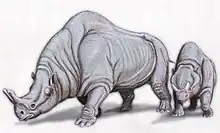Palaeosyops
Palaeosyops (Greek: "old" (paleos), "boar" (kapros), "face" (ops)[1]) is a genus of small brontothere which lived during the early to middle Eocene.[2]
| Palaeosyops Temporal range: | |
|---|---|
 | |
| Palaeosyops robustus skeleton | |
| Scientific classification | |
| Domain: | Eukaryota |
| Kingdom: | Animalia |
| Phylum: | Chordata |
| Class: | Mammalia |
| Order: | Perissodactyla |
| Family: | †Brontotheriidae |
| Genus: | †Palaeosyops |
| Species | |
| |
Biology and size

It was about the size of small cattle, with a weight of 600–800 kg depending on the species.[3]
These animals are commonly found in Wyoming fossil beds primarily as fossilized teeth. From all of the species of this animal, it is concluded that P. major was the largest, reaching the size of a small cow. Its describer, Joseph Leidy, erroneously thought that Palaeosyops consumed both plants and animals after examining the fang-like canines. However, it is now known that all brontotheres were strict herbivores, and that many, if not most genera of hornless brontotheres had fang-like canines, possibly for both defense from predators, and intraspecific competition.
References
- "Glossary. American Museum of Natural History". Archived from the original on 20 November 2021.
- "Fossilworks: Palaeosyops".
- "Paleobiology Database: Palaeosyops robustus". Archived from the original on 2012-12-10. Retrieved 2012-06-03.
